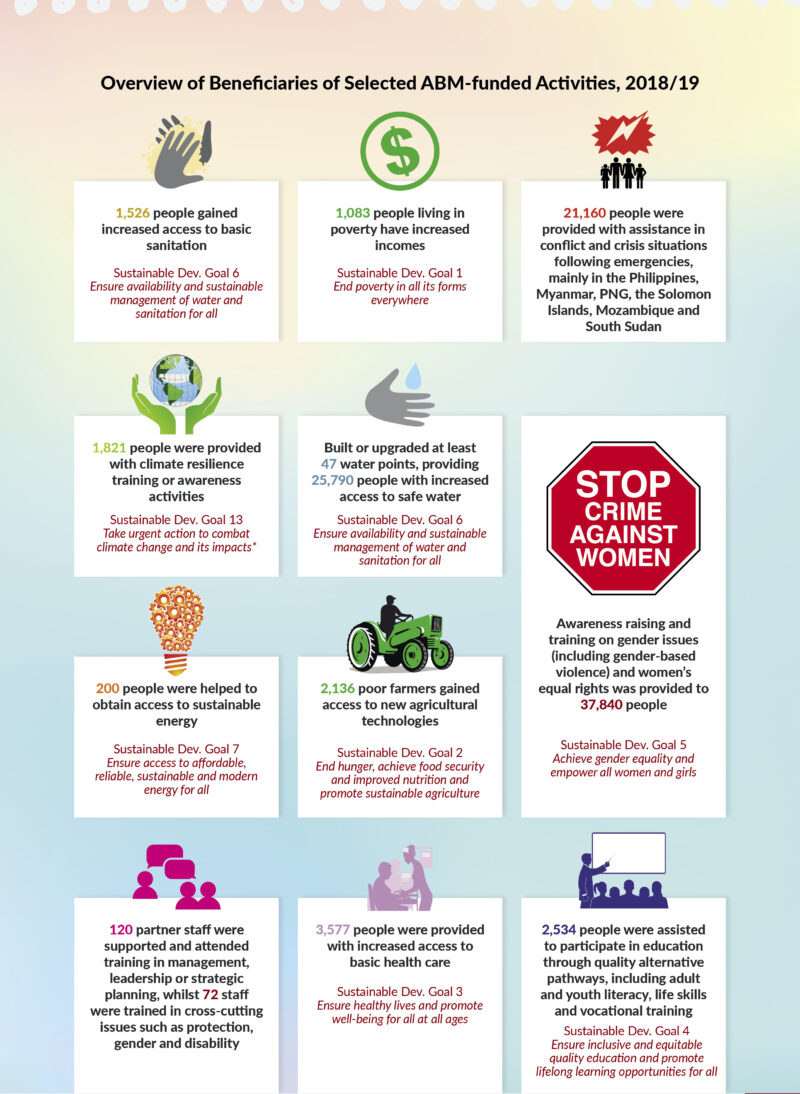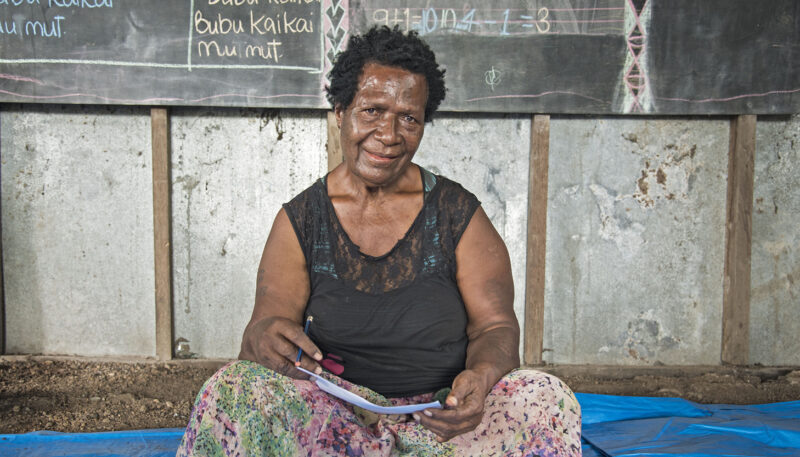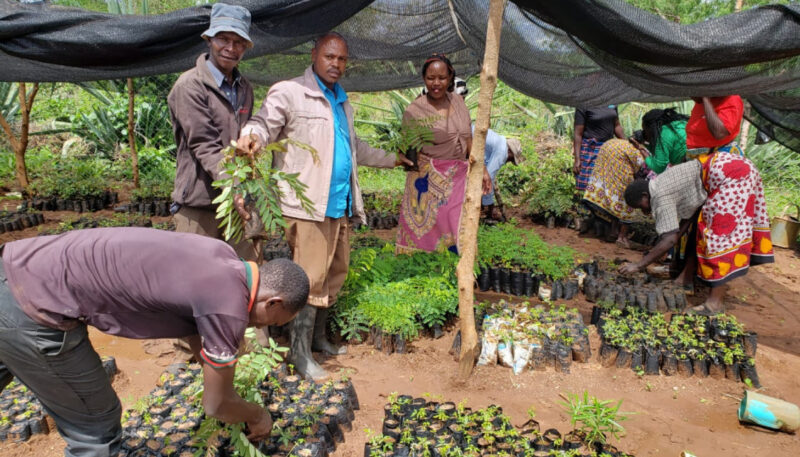ABM Archive Website
THIS WEBSITE CONTAINS ARCHIVE MATERIALS FOR HISTORICAL REFERENCE ONLY
For up-to-date information, including our latest appeals, news, and resources, please visit our current website.
Last year, you helped us to help more than 95,000 people
Every year, the Anglicans in Development unit of ABM analyses the effectiveness of its aid projects. For the financial year ended 30 June, 2019, ABM’s community development and humanitarian response activities reached more than 50 communities and more than 95,000 people across twelve countries: Papua New Guinea, Vanuatu, the Solomon Islands, the Philippines, Myanmar, Kenya, Zambia, Palestine, South Sudan, Mozambique, Indonesia and Tonga.
See these key quantitative results at a glance:

Page 22 of ABM’s 2018/19 Annual Report.
Read on to find out some of the most significant impacts.
Innovative technologies were used to improve livelihoods
New technologies adopted in Kenya, Myanmar and the Philippines included digging of zai pits (for water and fertiliser retention), organic stock feeds, vermicomposting, irrigation technologies, and drought-resistant seeds. In the Philippines, six community groups established by ABM’s partner, VIMROD, from July 2016 to December 2017 were, by June 2019, generating 600 to 3,300 pesos (AUD$ 17 – 85) per member per month. From ABM’s other Philippines partner, E-CARE, of the community groups that were established between 2013 and 2018, 1,351 households surveyed had increased their income from 6% to 59% from their program activities.
For comments from individual beneficiaries about how their lives have changed, see pp.5, 9, 15 and 21 in the ABM Project Book 2020. See also case studies from business cooperatives in Zambia and the Philippines.
Improved literacy opened doors for people in remote communities
Very remote communities in Vanuatu and Papua New Guinea improved their access to literacy, as well as to discussion of various social issues, such as gender-based violence, disability inclusion, and child protection. An evaluation of the PNG literacy program found that it was reaching more than 2,000 learners each year. Learners used their new literacy skills to complete job applications and government forms, read books and newspapers, read street signs and posters, participate more actively in church services and other community events, exchange notes with their family members, engage with their children’s schooling, and send and read mobile phone text messages. They also gained numeracy skills, which they used to calculate prices at the local market. In New Guinea Islands Diocese, some were using their numeracy skills to weigh oil palms. In Siane, some learners had opened personal bank accounts. Learners gained self-confidence. One Anglicare teacher noted that without literacy, people often felt intimidated when peers used fancy words. But after they attended classes their vocabulary improved, and they no longer felt intimidated.

Literacy Student, Soke Andrew, was one of 2,000 learners in the Anglicare PNG program © Ivy Wang, ABM.
Community commitment and contributions to projects
ABM’s projects right across Africa, Asia and the Pacific drew good community contributions, including labour, local materials, land and supervisory committees. ABM’s Vanuatu partner, the Anglican Church of Melanesia (ACOM), drew on community volunteers to teach literacy and build and maintain water, sanitation and hygiene facilities. Anglicare PNG drew on community contributions in the form of labour and materials for construction of schools, and nearby Anglican and government-run schools sometimes providing supplementary stationery. In the Solomon Islands, ACOM obtained strong community assistance with providing transport and labour for the installation of three water tanks. In the Philippines, all the community groups facilitated by VIMROD and E-CARE contributed some of their own capital, alongside capital provided by the project. With the E-CARE groups, there was a requirement to ‘pass on’ to another group the capital provided by the project, so money ‘passed on’ from one group to another was also a kind of community contribution. In many communities, the local church provided a meeting venue and the local clergy assisted with project monitoring. Community groups often accessed government experts to lead trainings.
You can read stories and testimonies from beneficiaries about their own participation in programs. U Yaw Sung talks about his contribution to WASH projects in Myanmar and Joness and Naumi Mutuku talk about how they have adopted new agricultural approaches in Kenya.
Positive impacts on the environment
ABM’s programming positively affected the environment. Tree-planting in Kenya, Myanmar and the Philippines is likely to have reduced soil erosion and water evaporation. ABM’s Kenyan partner, ADSE organised the planting of 6,000 trees, 70% of which survived. Training of community members in how to construct fuel-efficient stoves led to the construction of 58 such stoves in FY 2018/19. This meant that fewer trees were felled for firewood. Finally, the promotion of compost and other organic fertiliser in Myanmar, Kenya and the Philippines is likely to have improved soil quality.

Members of Kima Self-Help Group in Kenya sort nursery trees for sale to fellow community members to assist in soil conservation © Anglican Development Services, Eastern.
For more details about ABM’s livelihoods, education and environmental programs, see pp.12 and 17-20 in ABM’s FY 2018/19 Annual Report.
Challenges and recommendations
ABM’s analysis also identified four key challenges and made recommendations to address these.
Challenge of measuring impacts of activities
To address this challenge, it is suggested that ABM’s partners might: better track the follow-up from some of their training activities; gather clearer data on how environmental initiatives and livelihoods training is impacting incomes; and provide clearer data on the current health of some of the savings and loans cooperatives that have been set up.
Challenge of greater local involvement
ABM should support its Pacific partners to better monitor and energise local committees, including publicly recognising their efforts and assisting them to plan local fund-raising.
Challenge of programming for greater environmental sustainability
ABM should review its draft Climate Action strategy and scale up its climate resilience work in countries most affected by climate change.
Challenge of increasing disability inclusion
ABM should support greater disability inclusion, at least for some partners who do not yet integrate people with a disability into their programming. ABM’s partners who already integrate disability could serve as models to other ABM partners.
ABM regularly checks progress against recommendations.
By identifying our partners’ key impacts and any challenges, ABM is helping to ensure its programs support people to help themselves out of poverty, challenge injustice and protect the environment.


